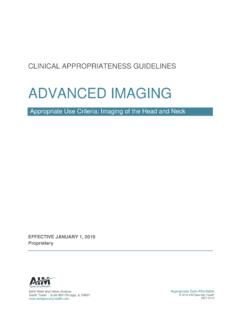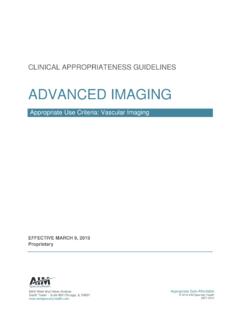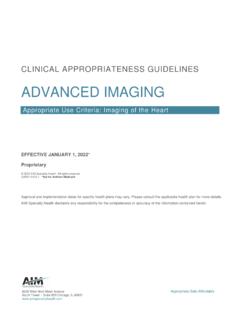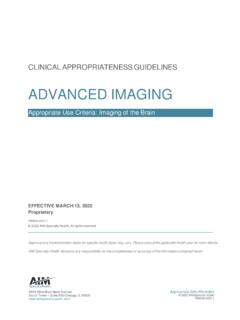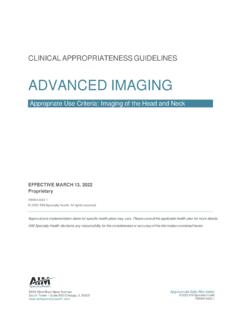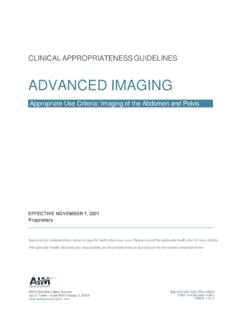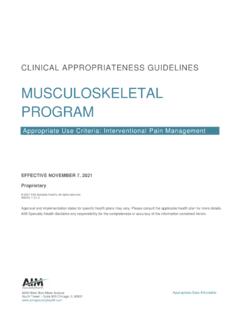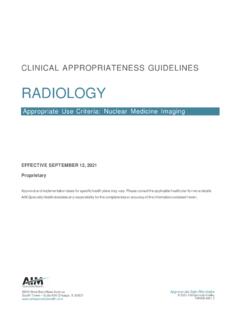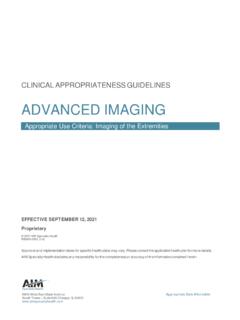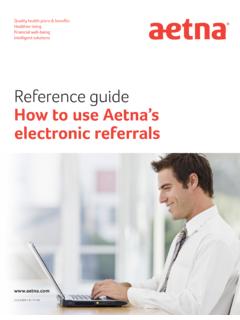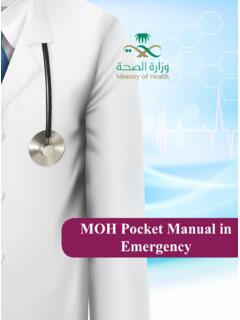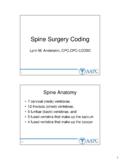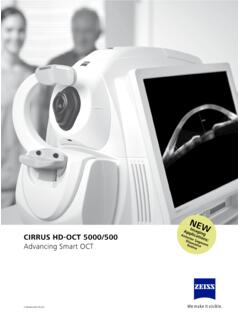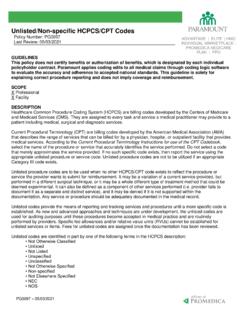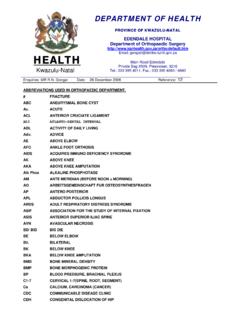Transcription of Musculoskeletal Program Clinical Appropriateness ...
1 2019 AIM Specialty Health 2063-0119 Spine surgery Guidelines Musculoskeletal Program Clinical Appropriateness Guidelines Spine surgery EFFECTIVE JANUARY 01, 2019 LAST REVIEWED SEPTEMBER 12, 2018 Copyright 2019. AIM Specialty Health. All Rights Reserved. Spine surgery 2 Table of Contents Spine surgery Guidelines .. 1 Description and Application of the Guidelines .. 4 Cervical Decompression With or Without Fusion .. 5 Description .. 5 General Requirements .. 6 Criteria .. 7 Exclusions .. 9 Selected References.
2 9 CPT Codes .. 9 History .. 12 Cervical Disc Arthroplasty .. 13 Description .. 13 General Requirements .. 13 Criteria .. 14 Contraindications .. 14 Exclusions .. 15 Selected References .. 15 CPT Codes .. 15 History .. 16 Lumbar Disc Arthroplasty .. 17 Description .. 17 General Requirements .. 17 Criteria .. 18 Contraindications .. 18 Exclusions .. 19 Selected References .. 19 CPT Codes .. 19 History .. 19 Lumbar Discectomy, Foraminotomy, and Laminotomy .. 20 Description .. 20 General Requirements .. 20 Criteria .. 21 Exclusions.
3 21 Selected References .. 22 CPT Codes .. 22 History .. 22 Lumbar Fusion and Treatment of Spinal Deformity (including Scoliosis and Kyphosis) .. 23 Description .. 23 General Considerations and Requirements .. 23 Criteria .. 25 Copyright 2019. AIM Specialty Health. All Rights Reserved. Spine surgery 3 Exclusions .. 27 Selected References .. 27 CPT Codes .. 28 History .. 30 Lumbar Laminectomy .. 31 Description .. 31 General Requirements .. 31 Criteria .. 32 Exclusions .. 32 Selected References .. 33 CPT Codes .. 33 History.
4 34 Noninvasive Electrical Bone Growth Stimulation .. 35 Description .. 35 Criteria .. 35 Exclusions .. 35 CPT/HCPCS Codes .. 36 History .. 36 Vertebroplasty/Kyphoplasty .. 37 Description .. 37 Criteria .. 37 Contraindications .. 38 Exclusions .. 38 Selected References .. 38 CPT Codes .. 38 History .. 39 Bone Graft Substitutes and Bone Morphogenetic Proteins .. 40 Description .. 40 General Considerations .. 40 Criteria .. 40 Exclusions .. 41 CPT/HCPCS Codes .. 41 History .. 42 Copyright 2019. AIM Specialty Health. All Rights Reserved.
5 Spine surgery 4 Description and Application of the Guidelines AIM s Clinical Appropriateness Guidelines (hereinafter AIM s Clinical Appropriateness Guidelines or the Guidelines ) are designed to assist providers in making the most appropriate treatment decision for a specific Clinical condition for an individual. As used by AIM, the Guidelines establish objective and evidence-based, where possible, criteria for medical necessity determinations. In the process, multiple functions are accomplished: To establish criteria for when services are medically necessary To assist the practitioner as an educational tool To encourage standardization of medical practice patterns To curtail the performance of inappropriate and/or duplicate services To advocate for patient safety concerns To enhance the quality of healthcare To promote the most efficient and cost-effective use of services AIM s guideline development process complies with applicable accreditation standards.
6 Including the requirement that the Guidelines be developed with involvement from appropriate providers with current Clinical expertise relevant to the Guidelines under review and be based on the most up to date Clinical principles and best practices. Relevant citations are included in the References section attached to each Guideline. AIM reviews all of its Guidelines at least annually. AIM makes its Guidelines publicly available on its website twenty-four hours a day, seven days a week. Copies of the AIM s Clinical Appropriateness Guidelines are also available upon oral or written request.
7 Although the Guidelines are publicly-available, AIM considers the Guidelines to be important, proprietary information of AIM, which cannot be sold, assigned, leased, licensed, reproduced or distributed without the written consent of AIM. AIM applies objective and evidence-based criteria and takes individual circumstances and the local delivery system into account when determining the medical Appropriateness of health care services. The AIM Guidelines are just guidelines for the provision of specialty health services. These criteria are designed to guide both providers and reviewers to the most appropriate services based on a patient s unique circumstances.
8 In all cases, Clinical judgment consistent with the standards of good medical practice should be used when applying the Guidelines. Guideline determinations are made based on the information provided at the time of the request. It is expected that medical necessity decisions may change as new information is provided or based on unique aspects of the patient s condition. The treating clinician has final authority and responsibility for treatment decisions regarding the care of the patient and for justifying and demonstrating the existence of medical necessity for the requested service.
9 The Guidelines are not a substitute for the experience and judgment of a physician or other health care professionals. Any clinician seeking to apply or consult the Guidelines is expected to use independent medical judgment in the context of individual Clinical circumstances to determine any patient s care or treatment. The Guidelines do not address coverage, benefit or other plan specific issues. If requested by a health plan, AIM will review requests based on health plan medical policy/guidelines in lieu of the AIM s Guidelines.
10 The Guidelines may also be used by the health plan or by AIM for purposes of provider education, or to review the medical necessity of services by any provider who has been notified of the need for medical necessity review, due to billing practices or claims that are not consistent with other providers in terms of frequency or some other manner. CPT (Current Procedural Terminology) is a registered trademark of the American Medical Association (AMA). CPT five digit codes, nomenclature and other data are copyright by the American Medical Association.
